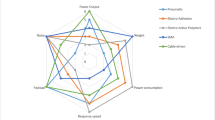Abstract
Tactile sensing ability is important for social robots, which perform daily work instead of persons. The authors have developed a three-axis tactile sensor based on an optical measurement method. Since our optical three-axis tactile sensor can measure distributed tri-axial tactile data, a robot equipped with the tactile sensors can detect not only grasping force but also slippage from its hands. In this paper, the authors have two objectives: one of them is evaluation of the three-axis tactile sensor in actual robotic tasks; the other is to demonstrate effectiveness of tri-axial tactile data for motion control. To accomplish these objectives, the authors have developed a two-hand-arm robot equipped with three-axis tactile sensors. In the robot motion control, we implement a recurrent mechanism in which the next behavior is induced by the tactile data to make the robot accept intention embedded in the environment. Since this mechanism is based on the tactile data, it is easy to apply it to communication between the hand-arms to obtain the best timing for cooperative work. In a series of experiments, the two-hand-arm robot performed object transfer and assembling tasks. Experimental results show that this tri-axial tactile base programming works well because appropriate behavior is induced according to slippage direction.
Similar content being viewed by others
References
Nicholls HR, Lee MH (1989) A survey of robot tactile sensing technology. Int J Robot Res 8–3:3–30
Göger D, Gorges N, Wörrn H (2009) Tactile sensing for an anthropomorphic robotic hand: hardware and signal processing. In: 2009 IEEE int conf on robotics and automation, pp 895–901
Ho VA, Dao DV, Sugiyama S, Hirai S (2009) Analysis of sliding of a soft fingertip embedded with a novel micro force/moment sensor: simulation, experiment, and application. In: 2009 IEEE int conf on robotics and automation, pp 889–894
Mott H, Lee MH, Nicholls HR (1984) An experimental very-high-resolution tactile sensor array. In: Proc 4th int conf on robot vision and sensory control, pp 241–250
Tanie K, Komoriya K, Kaneko M, Tachi S, Fujiwara A (1986) A high-resolution tactile sensor array. In: Robot sensors vol 2: Tactile and non-vision. IFS, Kempston, pp 189–198
Kaneko M, Maekawa H, Tanie K (1992) Active tactile sensing by robotic fingers based on minimum-external-sensor-realization. In: 1992 IEEE int conf on robotics and automation, pp 1289–1294
Maekawa H, Tanie K, Komoriya K, Kaneko M, Horiguchi C, Sugawara T (1992) Development of a finger-shaped tactile sensor and its evaluation by active touch. In: 1992 IEEE int conf on robotics and automation, pp 1327–1334
Ohka M, Mitsuya Y, Matsunaga Y, Takeuchi S (2004) Sensing characteristics of an optical three-axis tactile sensor under combined loading. Robotica 22-2:213–221
Ohka M, Kobayashi H, Takata J, Mitsuya Y (2008) An experimental optical three-axis tactile sensor featured with hemispherical surface. J Adv Mech Des Syst Manuf 2(5):860–873
Ohka M, Takata J, Kobayashi H, Suzuki H, Morisawa N, Yussof HB (2009) Object exploration and manipulation using a robotic finger equipped with an optical three-axis tactile sensor. Robotica 27:763–770
Brooks RA (1986) A robust layered control system for a mobile robot. IEEE J Robot Autom 2(1):14–23
Kube CR, Zhang H (1993) Controlling collective tasks with an ALN. In: IEEE/RSJ int conf on intelligent robots and systems, pp 289–293
Winston PH (1984) Artificial intelligence, 2nd edn. Addison-Wesley, Reading, pp 159–204
Ohka M, Morisawa N, Yussof HB (2009) Trajectory generation of robotic fingers based on tri-axial tactile data for cap screwing task. In: 2009 IEEE int conf on robotics and automation, pp 883–888
Author information
Authors and Affiliations
Corresponding author
Rights and permissions
About this article
Cite this article
Ohka, M., Abdullah, S.C., Wada, J. et al. Two-Hand-Arm Manipulation Based on Tri-axial Tactile Data. Int J of Soc Robotics 4, 97–105 (2012). https://doi.org/10.1007/s12369-011-0131-x
Accepted:
Published:
Issue Date:
DOI: https://doi.org/10.1007/s12369-011-0131-x




